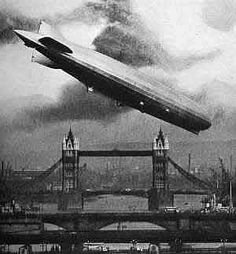German Zeppelins Attack London; Scores Killed.
‘The First Terror Weapon’
Special to The Great War Project
(13-16 October) Germany is dramatically stepping up the air war against Britain.
On the night of October 13th, a century ago, “five German Zeppelin airships took part,” writes historian Martin Gilbert, “dropping 189 bombs on London and the Home Counties [surrounding London]. Seventy-one civilians were killed.”
This is the heaviest air raid of the war so far, according to Gilbert.
Incendiary bombs begin raining down on London from an attack by Zeppelin in late May.
Nineteen-fifteen is showing a considerable expansion of the air war, using Zeppelins to bomb the British capital and other targets in Britain.
Earlier in the year, the Swedish historian Peter Englund tells the story of a young Belgian soldier, Willy Coppens, who watches the “enormous oval body of the airship move majestically and almost silently across the evening sky.”
Writes Englund, “It is a dreadful but impressive sight indeed, bordering on the sublime” as the airship, the length of two football fields, heads across the English Channel toward its targets in Britain.
Despite his hatred for the Germans, Coppens’ mind turns to the German flyers on the airship,
“how wonderful it must feel for those on board.”
The Zeppelin has already disappeared over the horizon, reports historian Englund, when two Belgian airplanes appear searching for “the great vessel.” But at this moment in the war, in the spring of 1915, no pilot has been able to shoot down a Zeppelin.
That comes later in June when a British pilot drops bombs above one of the great airships, causing it to crash.
Indeed the Zeppelins are quite nearly defenseless. But, Englund reports, the airships “are still surrounded by an aura of technological invulnerability and brutality. Which is the reason the Germans use airships in spite of their vulnerability to anti-aircraft fire and their sensitivity to wind and weather.”
“They frighten people,” Englund writes. “They are the first terror weapon.”
“To a very great extent, it is the civilian population that suffers.”
“What of course is most terrifying is that this is a completely new way of waging war…The agitation in Britain was great and there were even demands that captured Zeppelin pilots should be executed.”
Writes historian Adam Hochschild, “The very idea that explosives could be dropped through the clouds onto homes, farms, streets, and schools hundreds of miles from the nearest battlefield seemed to represent an unprecedented level of savagery.”
“Barbarous weapons,” writes the Times.
“No one was emotionally prepared for it,” Hochschild reports, “not even soldiers back from the front.”
The Zeppelin that Willy Coppens sees that night, one hundred years ago, is part of a squadron of three airships sent out to attack targets in the southeast of England.
Only one of the three airships has any success at hitting targets, reports Englund. But the damage this night is very light: “one damaged house and one wounded girl.”
Still soon, only a few months later, the German airships are capable of much greater damage, like the killing and destruction that takes place over London, precisely a century ago.



